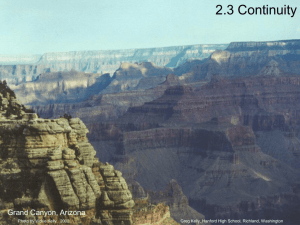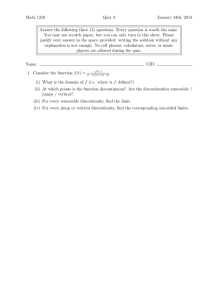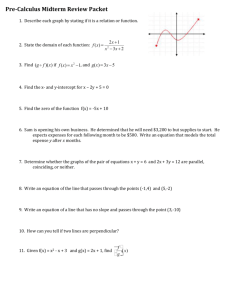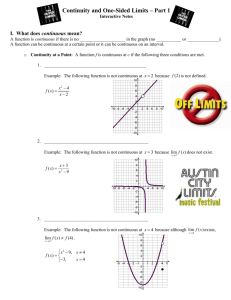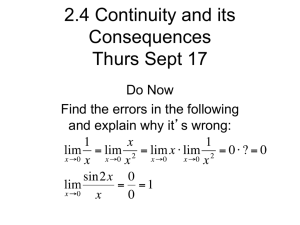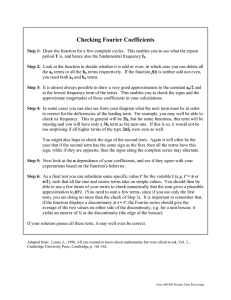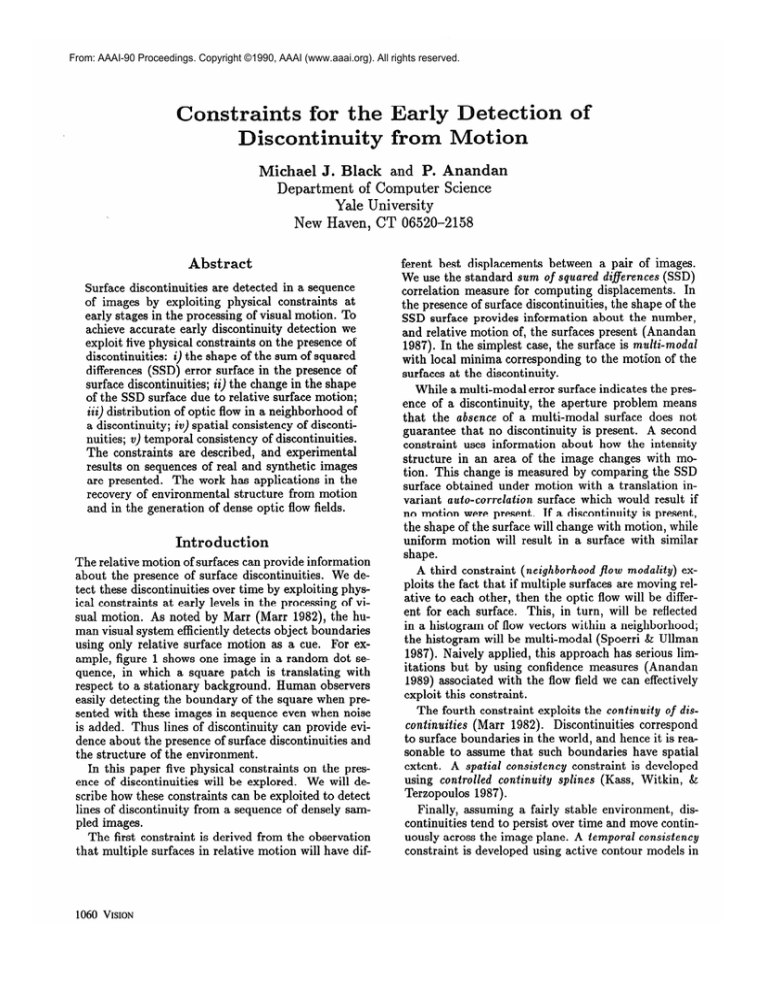
From: AAAI-90 Proceedings. Copyright ©1990, AAAI (www.aaai.org). All rights reserved.
Constraints
for the
iscontinuity
fro
Mot ion
Michael J. Black and P. Anandan
Department of Computer Science
Yale University
New Haven, CT 06520-2158
Abstract
Surface discontinuities are detected in a sequence
of images by exploiting physical constraints at
early stages in the processing of visual motion. To
achieve accurate early discontinuity detection we
exploit five physical constraints on the presence of
discontinuities: i) the shape of the sum of squared
differences (SSD) error surface in the presence of
surface discontinuities; G) the change in the shape
of the SSD surface due to relative surface motion;
G) distribution of optic flow in a neighborhood of
a discontinuity; iv) spatial consistency of discontinuities; V) temporal consistency of discontinuities.
The constraints are described, and experimental
results on sequences of real and synthetic images
are presented. The work has applications in the
recovery of environmental structure from motion
and in the generation of dense optic flow fields.
Introduction
The relative motion of surfaces can provide information
about the presence of surface discontinuities. We detect these discontinuities over time by exploiting physical constraints at early levels in the processing of visual motion. As noted by Marr (Marr 1982), the human visual system efficiently detects object boundaries
using only relative surface motion as a cue. For example, figure 1 shows one image in a random dot sequence, in which a square patch is translating with
respect to a stationary background. Human observers
easily detecting the boundary of the square when presented with these images in sequence even when noise
is added. Thus lines of discontinuity can provide evidence about the presence of surface discontinuities and
the structure of the environment.
In this paper five physical constraints on the presence of discontinuities will be explored. We will describe how these constraints can be exploited to detect
lines of discontinuity from a sequence of densely sampled images.
The first constraint is derived from the observation
that multiple surfaces in relative motion will have dif-
1060 VISION
ferent best displacements between a pair of images.
We use the standard sum of squared digerences (SSD)
correlation measure for computing displacements. In
the presence of surface discontinuities, the shape of the
SSD surface provides information about the number,
and relative motion of, the surfaces present (Anandan
1987). In the simplest case, the surface is multi-modal
with local minima corresponding to the motion of the
surfaces at the discontinuity.
While a multi-modal error surface indicates the presence of a discontinuity, the aperture problem means
that the absence of a multi-modal surface does not
guarantee that no discontinuity is present. A second
constraint uses information about how the intensity
structure in an area of the image changes with motion. This change is measured by comparing the SSD
surface obtained under motion with a translation insurface which would result if
variant auto-correlation
no motion were present. If a discontinuity is present,
the shape of the surface will change with motion, while
uniform motion will result in a surface with similar
shape.
A third constraint (neighborhood flow modality) exploits the fact that if multiple surfaces are moving relative to each other, then the optic flow will be different for each surface. This, in turn, will be reflected
in a histogram of flow vectors within a neighborhood;
the histogram will be multi-modal (Spoerri & Ullman
1987). Naively applied, this approach has serious limitations but by using confidence measures (Anandan
1989) associated with the flow field we can effectively
exploit this constraint.
The fourth constraint exploits the continuity of discontinuities (Marr 1982). Discontinuities correspond
to surface boundaries in the world, and hence it is reasonable to assume that such boundaries have spatial
extent. A spatial consistency constraint is developed
using controlled continuity splines (Kass, Witkin, &
Terzopoulos 1987).
Finally, assuming a fairly stable environment, discontinuities tend to persist over time and move continuously across the image plane. A temporal consistency
constraint is developed using active contour models in
Figure 1: Random Dot Image. One image from a
motion pair in which a foreground patch is undergoing a 2 pixel displacement with respect to a stationary
background. Zero mean gaussian noise with a standard
deviation equal to 10 percent of the standard deviation
of the image has been added to the second image.
which an energy term constrains the motion of the contour to be consistent with image flow.
Motivation
and Previous
Work
This work has two main motivations.
First, one of
the primary goals of computer vision is to recover the
structure of the environment; surface discontinuities
provide a great deal of structural information. Traditional edge detection techniques have well known
limitations for boundary detection. They may fail to
detect boundaries between textured surfaces, and detect many edges which do not correspond to structural properties of the environment but are artifacts
of surface marking. Motion based discontinuity detection, may be able to be combined with edge detection
schemes to produce more accurate and complete descriptions of the environment.
Secondly, we would like to incorporate information
about discontinuities into the computation of dense
optic flow fields over time (Schunk 1989) (Spoerri &
Ullman 1987). One of the key observations underlying work in optic flow computation is the notion that
surface discontinuities are not dense. Or phrased another way, that flow changes gradually across the field
of view. This allows smoothness constraints to be introduced into the flow field computation which correct for noise in image correlation. This assumption
of a smoothly changing flow field is violated at object boundaries, and hence the smoothness constraint
is not appropriate across these boundaries. By explicitly computing surface discontinuities at early stages of
motion processing, discontinuity information can be incorporated into the smoothness constraint to produce
more accurate flow fields.
Most previous attempts at detecting discontinuities
from motion have focused on an analysis of this flow
field using region growing (Potter 1980) or edge detection techniques (Thompson, Mutch, & Berzins 1982).
A variation on this approach (Mutch & Thompson
1988) computes accretion/deletion
regions using correlation techniques. Another approach, which we will
also exploit, uses information about the distribution of
flow vectors in a neighborhood about a point to decide
if a discontinuity is present (Spoerri & Ullman 1987).
These previous approaches suffer from two problems. First, they all ignore valuable information that
is present in the correlation surface from which the
flow is derived. Secondly, many occur too late in the
flow computation; to work they must be applied to
a smoothed flow field. When these techniques are applied to the raw, unsmoothed, flow field, the results are
poor. There is a Catch-22: you need the information
about discontinuities to derive an accurate smoothed
flow field, and you need the smoothed flow field to detect the discontinuities.
Our approach is novel in that we develop constraints
on the location of lines of discontinuity using information present in the SSD surface as well as physical
properties of discontinuities to achieve robust early detection. While the constraints have intuitive appeal,
and the experimental results are promising, we currently have no probabilistic justification for the confiden& measures- associated with these constraints and
no probabilistic interpretation is implied. This is an
area of ongoing research.
In the following sections each of the five constraints
is developed in detail and illustrated with experimental.
results on synthetic data. We then present experimental results with a real motion pair. Before concluding,
we discuss our current research directions.
Shape of the Error Surface
Correlation-based matching is a common technique
used in the computation of optic flow (Anandan 1989).
The approach is appealing for a variety of reasons; it
is simple, it captures the intuitive notion of similarity
between two image regions, and is inherently parallel.
The sum of squared differences (SSD) is a common
correlation measure which is computationally simple
and performs well in empirical tests when applied to
band-pass filtered images (Burt, Yen, & Xu 1982).
Given a point in an image and a set of points G in
a neighborhood of size n x m around the point, we
define the data error term for a displacement (u, V) of
that point as:
E(u,v)= E
(I&j) - &(i+ u,j + v))~,
i,jEG
where 11 and 12 denote the intensity functions of two
successive images. The SSD surface, S, is defined
over the space of possible displacements (u, V) with the
height of the surface corresponding to the data error,
E(u, v), of that displacement (figure 2 shows an example SSD surface at a corner point).
BLACKANDANANDAN
1061
\
u
Figure 2: Example SSD Surface at a Corner (inverted
for display).
Figure 3: Confidence, Cs, based on shape of the SSD
surface.
The shape of the SSD surface is typically quite complex and contains information about the motion of the
surfaces that gave rise to it (Anandan 1984). In particular, in certain well defined cases, if there are multiple
surfaces undergoing relative motion in a neighborhood,
then they will each have different best displacements.
surface with minThis gives rise to a multi-modalerror
ima corresponding to the displacements of each surface.
In an ideal situation, minima are easily detected by
examining the first and second partial derivatives of
the surface. Of course, when dealing with real imagery, detecting minima may not be so easy. In the
presence of noise, true minima may be obscured and
spurious minima may be introduced. Additionally, if
the relative motion of the surfaces is small, then due
to discretization, the peaks may merge together and
be indistinct. In practice then, we must settle for a
heuristic measure of peakness. One heuristic, $, takes
into account the steepness of the peak, by measuring
the distance of a point from its neighbors:
Experimental results with many confidence measures and heuristics indicate that simple measures, like
the ratio of the depths of the two best peaks, perform nearly as well as more complex measures. If the
first and second best peaks, as defined by $J, have
displacements (ue, vc) and (ui , vi) respectively, and
PO = S(UO, VO) and PI = S(ui, vi) are the depths of
the peaks, then we define Cs as:
$(u, v) = e
k
S(u, v) - S(u + i, v + j).
i=-1 j=-1
The more negative $, the more likely a steep peak exists. Other measures of peak shape and steepness exist.
For example, the scalar confidence measures of (Anandan 1984), which are based on normalized directio%al
second derivatives of the surface, provide a measure of
peakness based on curvature.
We desire an estimated confidence, Cs, that a particular image location corresponds to a discontinuity
given the shape of the SSD surface at that location.
Such a confidence measure should take into account
the number of peaks present in the surface and some
notion of how good these peaks are. We also take into
account that, for some distance on either side of a discontinuity, the SSD surface may contain evidence of
multiple motion. Our confidence measure should be
highest at the actual boundary.
1062 VISION
cs = POIPl.
This function will have a global maximum approaching 1.0 at the actual boundary and will fall off as distance from the boundary increases. Figure 3 shows
the values of CS obtained from the SSD surface generated between the images described in figure 1. Bright
values correspond to locations where there is a high
confidence of a discontinuity.
An empirical study of the behavior of the SSD surface indicates that in areas of sufficient texture the
surface contains enough information for discontinuity
detection.
However, if one or both of the surfaces
present are homogeneous, the aperture problem prevents us from deriving meaningful information from
the surface.
Weakening
the Continuity
Assumption
The SSD surface provides only approximate information about the displacement of multiple surfaces. It
embodies the assumption that the intensity structure
of a surface patch remains constant over time. This
assumption generally holds for surfaces which are continuous but is violated at surface discontinuities.
When using the quadratic SSD measure, the presence of a poorly correlated surface introduces noise
which influences the overall correlation. As the data error increases without bound so does the SSD measure.
Instead, we desire a function which weights highly differences which fall within the expected range of error and remains uncommitted about data outside this
range.
Figure 4: The 4 function embodying
nuity constraint.
the weak conti-
Figure 5: Confidence, Cs, using the weak continuity
assumption.
This weakening of the SSD assumption corresponds
to Blake and Zisserman’s weak continuity constraint
(Blake & Zisserman 1987). The following function, 4,
has the desired properties:
X2x2
402 = { C-Y
if 1x1< G/X,
otherwise
where X and cy are constants chosen with respect to
the expected noise. The resulting data error term is a
quadratic function of t’he difference in intensity values
as long as the magnitude of the difference is below
and stabilizes to a fixed value cy
a threshold fi/X,
beyond the threshold (see figure 4).
This function weights well correlated points highly
and diminishes the importance of poorly correlated
points. If there are multiple surfaces in relative motion, there will be multiple displacements where a high
number of points correlated well, and hence the correlation surface will contain multiple peaks.
The data error is now:
E(u, v) = ):
4(h(i,
i,jEG
j) - I2(i + u, j + v)).
The error surface is generated as before and peaks are
detected. Using the same confidence measure, C’s, as
before we see that the area of possible discontinuity is
more precisely located (figure 5).
Change
in Surface Shape
As indicated in the previous section, the SSD surface
may not have multiple peaks even when there are multiple surfaces in relative motion. In certain cases repetitive structures can cause multiple peaks in the SSD
surface when only a single motion is present. Hence,
we need a different approach to detect the absence
of discontinuities. The key observation is that if an
area is undergoing a uniform motion then the crosscorrelation surface, S, between successive frames will
have the same shape same as the auto-correlation surface, A, generated by correlating the the first image
with itself (Anandan 1984).
Figure 6: Confidence, CS,A, based on the change between the auto and cross correlation surfaces.
Intuitively, if the cross-correlation surface is similar
to the auto-correlation surface, given an appropriate
translation, then the likelihood iof a discontinuity is
low. We define a confidence measure, CS,A, based on
this intuition. We translate the auto-correlation surface so that it is centered at the point of best match,
(u, v), and compute the difference between the auto
and cross-correlation surfaces:
na
n
>:
(s(u,
v) - A(u, v))~.
CS,A =
x
u=-rn v=-n
This measure will be large at discontinuities and small
in areas of consistent motion. Multiple peaks in the
cross-correlation surface which are the result of repetitive structure will also appear in the auto-correlation
surface and hence CS,A will be low. This measure is
illustrated in figure 6 where CS,A is displayed for the
sample random dot pair.
Neighborhood
Flow
By taking the displacement of minimum error in the
SSD surface, we arrive at a raw, unsmoothed, flow field,
F. Each point in the field contains the best displacement of that point. Looking in a neighborhood around
BLACKANDANANDAN
1063
c
a
b
Figure 7: Detecting
discontinuities
using neighborhood
flow. a) Confidence,
CF, on neighborhood
of raw
flow vectors. b) Confidence, Cfiaas, in raw flow vectors c) Confidence, ‘CF,~,,,,, , combined neighborhood flow and
flow confidence.
Neighborhood Flow
a given point in F, if there are multiple surfaces moving relative to each other, then there will be clusters
of points with different flow vectors. A histogram of
displacement vectors in a neighborhood will contain
multiple peaks if a discontinuity is present (Spoerri &
Ullman 1987). Peaks are detected in the histogram
and a confidence measure, CF, can be created by comparing the relative heights of the two highest peaks.
At a boundary this measure has a global maximum
approaching 1.O.
Since the traditional smoothness process blurs the
distinction between neighboring flow vectors, the
neighborhood flow constraint must be applied prior
to smoothing. However, the unsmoothed flow field is
usually noisy and error-prone, hence, the resulting histogram will itself be unreliable. This is illustrated by
the example shown in Figure 7a, which is computed
from the random dot test pair. The measure is maximum near the actual boundary but, due to noise in
the unsmoothed flow field, it produces only a rough
approximation to the boundary.
The solution our dilemma is contained in the use of
confidence measures such as those described in (Anandan 1989). These provide a measure of confidence in a
flow estimate based on the curvature of the SSD surface. Figure 7b shows the confidence in the optic flow
estimates for the sample image pair. Areas where confidence in the flow estimate is low appear dark in the
figure. During the computation of the histogram, we
simply weight the contribution of each vector according to its associated confidence and find peaks in the
histogram as before. Flow vectors near the discontinuity that are unreliable will contribute less than in
the unweighted scheme. This approach cannot find a
discontinuity if the information is not present in the
flow field. Its usefulness is in reducing the confidence
of spurious discontinuities which are the result of flow
errors. The resulting confidence, CF,~,,,, for the test
images is shown in figure 7c.; confidence in the erroneously located discontinuity at the occluding corner
1064 VISION
has been reduced.
Note that our simple scheme for detecting multiple peaks may fail due to the discretization of the
histogram. For instance, two adjacent peaks in the
histogram may simply be a broad single peak. More
sophisticated clustering techniques may be needed to
deal with such problems, and will be considered in the
future.
Spatial
Consistency
Until now we have only discussed the assignment of a
confidence to a point in the optic array which has some
likelihood of corresponding to a discontinuity in the
environment. Since discontinuities result from objects
and their boundaries, and hence have spatial extent,
our goal is not to detect points, but to detect lines of
discontinuity which provide the best interpretation of
the evidence supplied by the other constraints. The
approach taken here is to construct a confidence field
based on the previous constraints and use controlled
continuity splines, or snakes, (Kass, Witkin, & Terzopoulos 1987) to detect local minima in the field.
We view the task of detecting lines of discontinuity as an energy minimization task where the internal
spline forces E int impose a smoothness constraint and
the pointwise discontinuity confidence imposes external forces Edise on the shape of the curve:
Es, =
&-at(s)
+&iisc(S)dS.
Jo1
Local minima of the energy function correspond to
possible lines of discontinuity and temporal, or higher
level, processes may then be able to choose the global
minima corresponding to actual discontinuities.
Our spatial consistency assumption gives us a model
of discontinuities as continuous curves in the environment. The shape of these curves can be described by
an internal spline energy function:
E bat = (4s>Iv&>12
+ P(41~ss(s)~2)/2
Similarly, we may require that the snake acceleration
G(s) be small.
The experiments reported in this paper have been
based on two frames, and hence do not exploit temporal consistency. It appears, however, that the inclusion
of this constraint for multiple-frame analysis will provide significant improvements.
Experimental
Figure 8:
Discontinuity
confidence
and spatial
consistency.
Line of discontinuity detected using spa-
tial consistency constraint superimposed on the confidence field, generated using Cs, CS,A, CF,~,,,
where v(s) = (Z(S), y(s)) represents the position of the
snake parametrically, v, and v,, are the first and second derivatives of the spline, and o(s) and ,0(s) control
to what extent the snake acts like a membrane and a
thin plate respectively.
We can combine the pointwise information about
discontinuity to form a confidence field 4 where wells
in the field correspond to areas where there is high
confidence that a discontinuity is present:
q =
l/(wlcS
+
W2CS,A + w3cF,C,,,),
where the wi are scalar weights. Other formulations of
the field are possible. The external energy force on the
discontinuity spline is then just where Edisc = wdisc$!.
Figure 8 shows the confidence field for the random
dot sequence with noise. A closed snake was initialized manually with an initial starting position roughly
near the discontinuity. The figure shows one local minimum found by the snake as bright against the darker
confidence field. The deep well about the discontinuity means initial placement of the snake can be fairly
inaccurate. In our current work we are exploring ways
of automating this instantiation process.
Temporal
Consistency
Lines of discontinuity correspond to boundaries of surfaces in the environment. Under the reasonable assumption that surfaces tend to persist in time, we can
expect that the discontinuities will also persist. This
temporal consistency of discontinuities provides a powerful constraint which can be used to disambiguate between possible lines of discontinuity.
Temporal consistency implies that lines of discontinuity will move steadily across the optic array. This
can be formulated as a constraint on the location and
the motion of the snakes.
In particular, thesnakevelocity c(s) should be consistent with the flow field of
the frontal surface which gives rise to the discontinuity.
Results
The constraints and associated confidence measures
provide accurate discontinuity detection in random dot
images, even in the presence of noise. These images,
however, contain more texture than is common in images of natural scenes. A sequence of 64 x 64 pixel
images of a cluttered office scene was used to test the
constraints on real data. The densely sampled sequence contains two relatively homogeneous bars in
the foreground moving across a stationary background
containing areas of varying amounts of texture. The
closest bar is undergoing approximately a 2 pixel displacement while the more distant bar is displaced by
approximately 1 pixel. Noise, multiple discontinuities,
and nearly homogeneous surfaces make this a challenging sequence for discontinuity detection.
The images were first band-pass filtered. The SSD
computation for the auto and cross correlation surfaces
used a 7 x 7 search area and a 7 x 7 neighborhood with
a uniform distribution. A 7 x 7 neighborhood was used
for computing neighborhood flow. Figure 9a shows a
thresholded image of the potential field generated using C’s, CS,A , and CF,~,,, . Dark areas correspond to
locations where there is high confidence that a discontinuity exists.
Snakes were initialized manually (figure 9b) in the
general area of the discontinuity. This initialization
process could be automated by using curves generated from intensity-based edge detection and perceptual grouping. Figure 9c shows the snakes resting at
local minima in the field.
Conclusion
This paper has presented physical constraints which
can be exploited to perform early detection of motion
discontinuities over time. We have also presented a
way of combining the various constraints in the form
of an optimization problem, along the lines of the active contour models developed by (Kass, Witkin, &
Terzopoulos 1987). Our approach is suitable for early
stages in the processing of visual motion, and produces
useful results even using our current formulation of the
constraints, which is admittedly somewhat simple.
We are currently working on a Bayesian interpretation for our constraints. A conditional probability for
a discontinuity can be obtained from each constraint
and these can then be combined. The Bayesian model
of the uncertainty developed in (Szeliski 1988) for flowfield computation provides hope that such a rigorous
treatment is possible.
BLACKANDANANDAN
1065
a
Figure 9: Experiments.
c)-final positions.
b
a) Threshold cIf potential field using Cs, CS,A and
There is also work to be done extending the constraints themselves; in particular, temporal constraints
need to be incorporated. The possibility that discontinuities may appear, merge, split, grow, and shrink
presents a number. of interesting challenges in the use
of snakes. The shape of the SSD surface and the use of
weak continuity constraints deserve additional study,
as do the possibilities for additional constraints. For
example, it may be possible to combine dynamic discontinuity analysis with static image analysis.
There are also possibilities for feeding these discontinuities back into the correlation process. By explicitly
accounting for discontinuities when computing the correlation it may be possible to achieve better estimates
of flow. This idea relates to work in Markov Random
Fields in which line processes are introduced to account
for discontinuities (Geman & Geman 1984).
Finally, the value of this work will be demonstrated
when it is applied to the problems of motion understanding. In particular, the incorporation of discontinuities into the smoothness constraint in flow field
computation needs to be examined. The test will be
whether early discontinuity detection can indeed be
used to produce more accurate dense flow fields.
References
[l] P. Anandan. Computing dense displacement fields
with confidence measures in scenes containing occlusion. In SPIE Int. Conf. Robots and Computer
Vision, 521, pages 184-194, 1984.
%Gna, -
b) initial snake positions.
151P.
J. Burt, C. Yen, and X. Xu. Local correlation
measures for motion analysis a comparative study.
Technical Report IPL-TR-024, Image Processing
Lab., Rensselaer Polytechnic Institute, 1982.
PI
S. Geman and D. Geman. Stochastic relaxation,
gibbs distributions, and bayesian restoration of
on Pattern Analysis
images. IEEE Transactions
and Machine Intelligence, PAMI-6(6), November
1984.
VI M.
Kass, A. Witkin, and D. Terzopoulos. Snakes:
Active contour models. In Proc. 1st ICCV, pages
259-268, June 1987. London, UK.
PI
D. Marr. Vision. W. H. Freeman and Company,
New York, 1982.
PI
M. Mutch, K. and B. Thompson, W. Analysis of
accretion and deletion at boundaries in dynamic
scenes. In W. Richards, editor, Natural Computation, pages 44-54. MIT Press, Cambridge, Mass.,
1988.
PO1L.
Potter, J. Scene segmentation using motion
information. IEEE Trans. on Systems, Man, and
Cybernetics, 5:390-394, 1980.
WI
B. 6. Schunk. Image flow segmentation and estimation by constraint line clustering. IEEE PAMI,
11(10):1010-1027, Oct. 1989.
Cl21A.
Spoerri and S. Ullman. The early detection
of motion boundaries. In Proc. 1st ICCV, pages
209-218. London, UK, June 1987.
[2] P. Anandan. Measuring Visual Motion from Image Sequences.
PhD thesis, University of Massachusetts, Amherst, 1987. COINS TR 87-21.
WI
R. S. Szeliski. Bayesian Modeling of Uncertainty
in Low-Level Vision. PhD thesis, Carnegie Mellon
University, 1988.
[3] P. Anandan. A computational framework and an
algorithm for the measurement of visual motion.
Int. Journal of Computer Vision, 2:283-310,1989.
M
W. B. Thompson, K. M. Mutch, and V. Berzins.
Edge detection in optical flow fields. In Proc. of
the Second National Conference on Artificial Intelligence, August 1982.
[4] A. Blake and A. Zisserman. Visual Reconstruction. The MIT Press, Cambridge, Massachusetts,
1987.
1066 VISION

